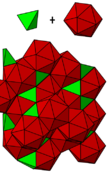|
Ten-of-diamonds decahedron
In geometry, the ten-of-diamonds decahedron is a space-filling polyhedron with 10 faces, 2 opposite rhombi with orthogonal major axes, connected by 8 identical isosceles triangle faces. Although it is convex, it is not a Johnson solid because its faces are not composed entirely of regular polygons. Michael Goldberg named it after a playing card, as a 10-faced polyhedron with two opposite rhombic (diamond-shaped) faces. He catalogued it in a 1982 paper as 10-II, the second in a list of 26 known space-filling decahedra.[1] CoordinatesIf the space-filling polyhedron is placed in a 3-D coordinate grid, the coordinates for the 8 vertices can be given as: (0, ±2, −1), (±2, 0, 1), (±1, 0, −1), (0, ±1, 1). SymmetryThe ten-of-diamonds has D2d symmetry, which projects as order-4 dihedral (square) symmetry in two dimensions. It can be seen as a triakis tetrahedron, with two pairs of coplanar triangles merged into rhombic faces. The dual is similar to a truncated tetrahedron, except two edges from the original tetrahedron are reduced to zero length making pentagonal faces. The dual polyhedra can be called a skew-truncated tetragonal disphenoid, where 2 edges along the symmetry axis completely truncated down to the edge midpoint.
Honeycomb
The ten-of-diamonds is used in the honeycomb with Coxeter diagram Cells can be seen as the cells of the tetragonal disphenoid honeycomb,
Related space-filling polyhedraThe ten-of-diamonds can be dissected in an octagonal cross-section between the two rhombic faces. It is a decahedron with 12 vertices, 20 edges, and 10 faces (4 triangles, 4 trapezoids, 1 rhombus, and 1 isotoxal octagon). Michael Goldberg labels this polyhedron 10-XXV, the 25th in a list of space-filling decahedra.[2] The ten-of-diamonds can be dissected as a half-model on a symmetry plane into a space-filling heptahedron with 6 vertices, 11 edges, and 7 faces (6 triangles and 1 trapezoid). Michael Goldberg identifies this polyhedron as a triply truncated quadrilateral prism, type 7-XXIV, the 24th in a list of space-fillering heptahedra.[3] It can be further dissected as a quarter-model by another symmetry plane into a space-filling hexahedron with 6 vertices, 10 edges, and 6 faces (4 triangles, 2 right trapezoids). Michael Goldberg identifies this polyhedron as an ungulated quadrilateral pyramid, type 6-X, the 10th in a list of space-filling hexahedron.[4] Rhombic bowtie
Pairs of ten-of-diamonds can be attached as a nonconvex bow-tie space-filler, called a rhombic bowtie for its cross-sectional appearance. The two right-most symmetric projections below show the rhombi edge-on on the top, bottom and a middle neck where the two halves are connected. The 2D projections can look convex or concave. It has 12 vertices, 28 edges, and 18 faces (16 triangles and 2 rhombi) within D2h symmetry. These paired-cells stack more easily as inter-locking elements. Long sequences of these can be stacked together in 3 axes to fill space.[5] The 12 vertex coordinates in a 2-unit cube. (further augmentations on the rhombi can be done with 2 unit translation in z.)
See alsoReferences
|
|||||||||||||||||||||||||||||||||||||||||||||||||||||||||||||||||||||||||||||||||||||||||||||||
Portal di Ensiklopedia Dunia


























